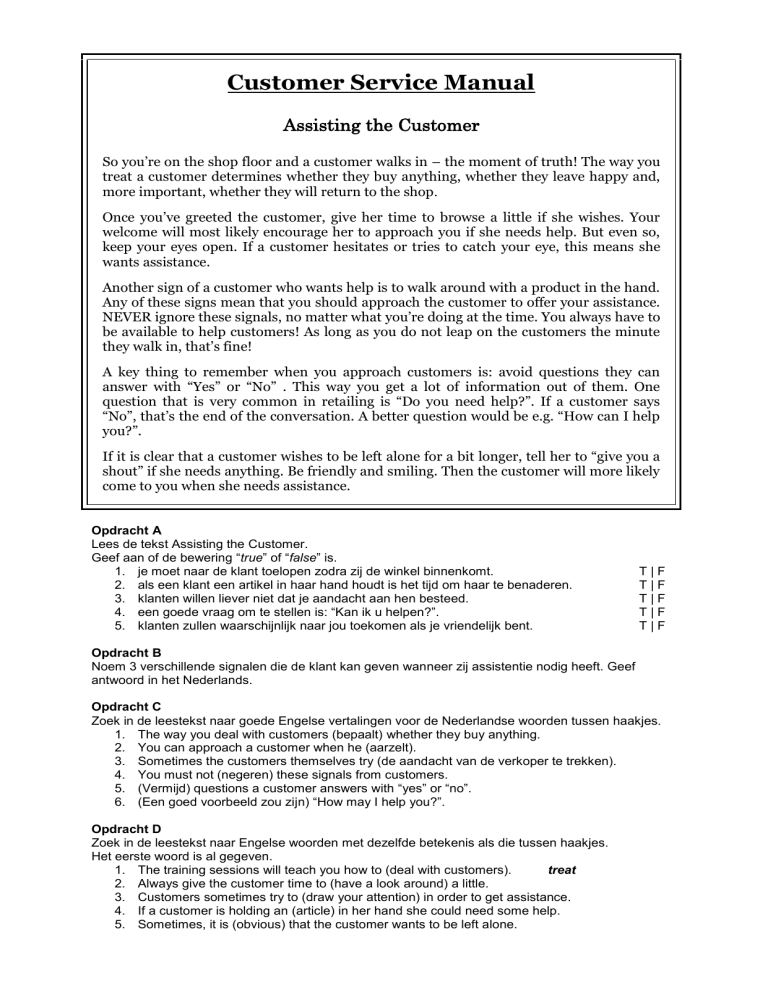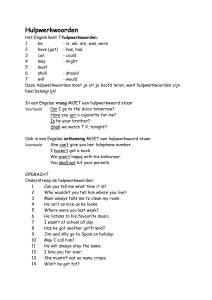
Customer Service Manual
Assisting the Customer
So you’re on the shop floor and a customer walks in – the moment of truth! The way you
treat a customer determines whether they buy anything, whether they leave happy and,
more important, whether they will return to the shop.
Once you’ve greeted the customer, give her time to browse a little if she wishes. Your
welcome will most likely encourage her to approach you if she needs help. But even so,
keep your eyes open. If a customer hesitates or tries to catch your eye, this means she
wants assistance.
Another sign of a customer who wants help is to walk around with a product in the hand.
Any of these signs mean that you should approach the customer to offer your assistance.
NEVER ignore these signals, no matter what you’re doing at the time. You always have to
be available to help customers! As long as you do not leap on the customers the minute
they walk in, that’s fine!
A key thing to remember when you approach customers is: avoid questions they can
answer with “Yes” or “No” . This way you get a lot of information out of them. One
question that is very common in retailing is “Do you need help?”. If a customer says
“No”, that’s the end of the conversation. A better question would be e.g. “How can I help
you?”.
If it is clear that a customer wishes to be left alone for a bit longer, tell her to “give you a
shout” if she needs anything. Be friendly and smiling. Then the customer will more likely
come to you when she needs assistance.
Opdracht A
Lees de tekst Assisting the Customer.
Geef aan of de bewering “true” of “false” is.
1. je moet naar de klant toelopen zodra zij de winkel binnenkomt.
2. als een klant een artikel in haar hand houdt is het tijd om haar te benaderen.
3. klanten willen liever niet dat je aandacht aan hen besteed.
4. een goede vraag om te stellen is: “Kan ik u helpen?”.
5. klanten zullen waarschijnlijk naar jou toekomen als je vriendelijk bent.
T|F
T|F
T|F
T|F
T|F
Opdracht B
Noem 3 verschillende signalen die de klant kan geven wanneer zij assistentie nodig heeft. Geef
antwoord in het Nederlands.
Opdracht C
Zoek in de leestekst naar goede Engelse vertalingen voor de Nederlandse woorden tussen haakjes.
1. The way you deal with customers (bepaalt) whether they buy anything.
2. You can approach a customer when he (aarzelt).
3. Sometimes the customers themselves try (de aandacht van de verkoper te trekken).
4. You must not (negeren) these signals from customers.
5. (Vermijd) questions a customer answers with “yes” or “no”.
6. (Een goed voorbeeld zou zijn) “How may I help you?”.
Opdracht D
Zoek in de leestekst naar Engelse woorden met dezelfde betekenis als die tussen haakjes.
Het eerste woord is al gegeven.
1. The training sessions will teach you how to (deal with customers).
treat
2. Always give the customer time to (have a look around) a little.
3. Customers sometimes try to (draw your attention) in order to get assistance.
4. If a customer is holding an (article) in her hand she could need some help.
5. Sometimes, it is (obvious) that the customer wants to be left alone.
ANTWOORDEN
Customer Service Manual
Assisting the Customer
Opdracht A
Lees de tekst Assisting the Customer.
Geef aan of de bewering “true” of “false” is.
1. F
2. T
3. F
4. F
5. T
Opdracht B
1. als de klant twijfelt
2. als de klant oogcontact provbeert te maken
3. als de klant rondloopt met een artikel in de hand
.
Opdracht C
Zoek in de leestekst naar goede Engelse vertalingen voor de Nederlandse woorden tussen haakjes.
1. determines
2. hesitates.
3. to catch your eye
4. ignore
5. avoid
6. a better question would be … / a good example would be ….
Opdracht D
Zoek in de leestekst naar Engelse woorden met dezelfde betekenis als die tussen haakjes.
Het eerste woord is al gegeven.
1. treat
2. browse.
3. catch your eye
4. product.
5. clear












